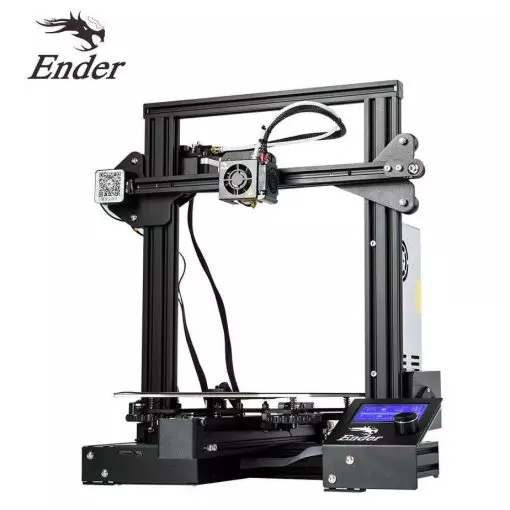Compare Ender 3 vs KP3S PRO V2
Comparison between the best 3D printers
Choose the best 3D printer at the best price. The cheapest 3D printers are here.
Buy a 3D printer here with 3D Fila.
 |
 |
|
| Model | Ender 3[BUY Ender 3] |
KP3S PRO V2 |
| Printing Material | Filament | Filament |
| Buy Filament for Creality 3D Ender 3 | Buy Filament forKingroon KP3S PRO V2 | |
| Estimated price | $210,00 | $229,00 |
| Manufacturer | Creality 3D | Kingroon |
| Release Year | 2018 | 2024 |
| Print Volume [mm] | 220x220x250 | 220x220x250 |
| Printer Size [mm] | 440x440x465 | 420x400x450 |
| Weight [kg] | 6,62 | 12,6 |
| Power Loss Recovery | NO | NO |
| Enclosed printer | NO | NO |
| Bed Leveling | Manual | Automatic |
| Filament End Sensor | NO | NO |
| Bed type | Heated | Heated |
| Power supply system | Bowden | Direct Drive |
| Standard nozzle | 0,4 | 0,4 |
| Maximum Nozzle Temperature [°C] | 255 | 260 |
| Maximum Bed Temperature [°C] | 110 | 100 |
| Maximum printing speed [mm/s] | 180 | 350 |
| Filament holder | YES | YES |
| Camera for supervision | NO | NO |
| Recommended filaments | PLA, TPU, ABS, PETG | PLA, PETG, TPU |
| Recommended slicers | Cura, Simplify, Slic3r | Cura, Orca Slicer |
| Maximum Resolution [mm] | 0,1 | 0,01 |
| Processor | 8 bits | |
| Display | Mono | LCD Mono |
| Power Supply | 24V / 270W | 300 W |
| Connectivity | SD / USB | USB-C / MicroSD / Ethernet |
| Operating systems | Windows, Mac, Linux | Windows, Mac, Linux |
| Date of registration in the system | 2021-04-13 | 2025-03-18 |
| Release date | 2018 | 2024 |
| Extra features | The Ender 3 V1 is a DIY assembly 3D printer, a sales leader since 2017, standing out for its cost-benefit. With a wide printing capacity, it has a CNC machined structure for precision and stability. It offers high-precision prints with low noise, thanks to its innovative V-profile and pulleys. It has a self-adhesive magnetic platform for easy removal of models and excellent adhesion. The Ender 3 heats up quickly, reaching 100°C in 5 minutes, ideal for agile prints. It includes protection against power failures, allowing you to resume printing after interruptions, saving time and material. | The Kingroon KP3S Pro V2 is a high-speed FDM 3D printer with Klipper firmware, ensuring fast and precise prints. It features linear rails on all axes, a Direct Drive extruder with a 9.5:1 gear ratio, and an efficient ceramic heater. It includes an inductive sensor for automatic bed leveling, a PEI magnetic bed, a built-in accelerometer for vibration calibration, and Wi-Fi, Ethernet, and USB connectivity for remote control. |
| Support for multiple colors and materials (AMS and CFS) | NO | NO |
Notes * |
||
| Cost-benefit | 6 / 10 | 7 / 10 |
| Hardware | 0.5 / 10 | 0.9 / 10 |
| Tela | . | . |
| Print volume | 3 / 10 | 3 / 10 |
| Performance | 1 / 10 | 3 / 10 |
| [BUY Ender 3] |
Conclusion |
| In comparing the Ender 3 and the KP3S PRO V2, several factors come into play that could influence a buyer's decision, particularly in terms of pricing, features, and overall performance. The Ender 3, which has been a market leader since its release in 2018, offers a solid balance of affordability and reliability, making it a popular choice among both beginners and seasoned enthusiasts. Its manual bed leveling, adequate print speed, and sizable print volume contribute to its status as a cost-effective option. However, it lacks some modern features such as automatic bed leveling and connectivity options, which may appeal to more tech-savvy users. On the other hand, the KP3S PRO V2, released in 2024, introduces numerous advancements that cater to users seeking enhanced performance. It boasts automatic bed leveling, faster maximum printing speeds, and a direct drive extruder that generally improves print quality with flexible materials. The inclusion of a more modern connectivity system (like USB-C and Ethernet) is also a significant upgrade that facilitates ease of use. Additionally, its construction with linear rails provides improved stability and precision. In summary, the Ender 3 is an excellent choice for those prioritizing affordability and the fundamentals of 3D printing, while the KP3S PRO V2 appeals to users willing to invest a bit more for advanced features and greater speed. Ultimately, the choice between the two should consider budget constraints, desired features, and intended use, ensuring that you select the model that best aligns with your 3D printing needs. |

